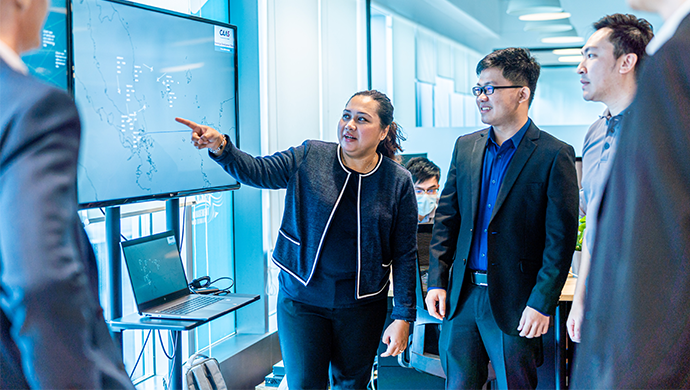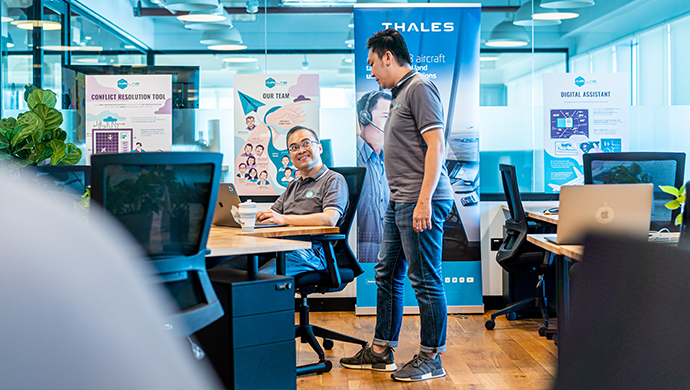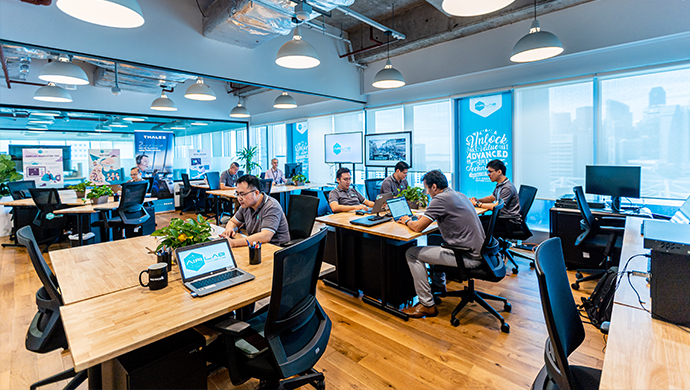
The adoption of advanced technologies such as Artificial Intelligence (AI), Machine Learning (ML), Big Data, and the Internet of Things (IoT) has accelerated in the past few years across many sectors and organisations – both large and small – have seen the potential benefits that could be brought to bear by these technologies. This is evident even more so in recent times where Covid-19 restricted how businesses could normally conduct their day-to-day operations and the adoption of advanced technologies has allowed them to stay relevant amidst the challenges.
While the rate of advanced technology adoption varies across industry sectors, French tech giant Thales Group and the Civil Aviation Authority of Singapore (CAAS) saw the need to leverage co-innovation to accelerate the adoption of advanced technologies in Air Traffic Management (ATM).
In November 2019, CAAS and Thales established the Aviation Innovation Research (AIR) Lab. The joint lab brings together multiple stakeholders in the ATM value chain – from air traffic controllers to AI experts and local start-ups, all supported by expert ATM engineers and software engineers specializing in latest technologies – creating a veritable ‘sandbox’ where the diverse team can experiment and co-create the future ATM capabilities, leveraging technologies such as Cloud native frameworks, DevOps CI/CD automation, big data, AI / ML etc.
The multi-disciplinary team adopts an agile ‘build-test-and-learn’ methodology, working in short sprints that enable Minimum Viable Proof-of-Concepts (MVPs) to be co-developed in a shorter time frame.
One concept which motivated the conception of AIR Lab is the core belief that diversity in perspectives combined with the latest open technologies can precipitate out-of-the-box solutions which will be key enablers for future ATM systems. It is not just traditional ATM engineers who are involved, but also the operational air traffic control users and the “young” tech talent of innovative start-ups and enterprising developers who can envision a digital ATM future that is both technically advanced and ready to meet the many challenges of the aviation sector such as eco-friendly “green” operational concepts to address carbon emission objectives.
Leveraging data for innovation: AIR Lab’s Open ATM Architecture and APIs

AIR Lab’s first priority since its inception was to develop an Open ATM architecture.
The adoption of open, standard technologies on an Open ATM platform will benefit the entire ATM ecosystem by reducing the ‘build-test-learn’ MVP life-cycle. With the shortened lifecycle, smarter, safer, more efficient and secured airspace management capabilities can be made available earlier.
The MVP approach adopted for the AIR Lab’s Open ATM architecture programme uses Scrum practices and the Agile framework. These practices and the use of open technologies including public APIs for service access align with the latest IT industry trends, thus enabling collaborations with the broader IT / start-up ecosystem as well as the nurturing of the next-generation talent for the ATM industry.
Also read: Solving multiple medtech problems with a single device powered by AI
An Open ATM platform will also enable data and service exchanges at the B2B / enterprise level, allowing multiple stakeholders to provide and consume data/services on the platform.
Imagine the potential applications that can be co-created when Air Navigation Service Providers (ANSPs), airlines and airports share data related to operations such as flight trajectories, weather, planning constraints, connecting passengers/cargo amongst many others, and share common optimization objectives which can benefit all stakeholders in the aerospace value chain.
Safe and Secure Data Management
The work in AIR Lab also involves ensuring data is shared in a safe and secured manner. AIR Lab’s Chief Product Owner Mr Hugh Rodrick, said, “A common misconception is that Agile, Scrum and MVP are equivalent to throwing the systems engineering rule book away. This is not the case. Setting out a solution and design which appropriately addresses the needs whilst respecting the system constraints, (e.g. safety, security, quality, maintainability, etc.) remains paramount.”
“One key need of AIR Lab’s Open ATM platform is to enable access to ATM services using public (secured) APIs based on open technologies, whilst allowing integration of third-party capabilities as services,” he added.
When the Open ATM platform is connected to an operational ATM system (such as the Thales LORADS III that is currently operating at the Singapore Air Traffic Control Centre), such systems constraints must be respected as we allow for real air traffic control data to be shared with trusted collaboration partners. The entire process must adhere highest levels of cybersecurity measures which limit access and ensure potential “attack-surfaces” are identified and minimised – all of which are built into the Open ATM platform using the latest web security features.
Also read: TuringCerts combats fraud with blockchain-powered certificate validation
The Open ATM platform’s public API gateway limits access through the use of authorisation keys and is prepared for role-based credentialed access. It is also designed to allow Open ATM system services to have multiple “personalities” such as a privileged API set that is only accessible by clients who connect from within a defined IT domain, such as a CAAS facility.
This subsequently allows sensitive air traffic control data to be leveraged from within air navigation service providers such as CAAS, but excluded from the data provided to the public API personality.
Safety is also addressed through such cybersecurity measures. By effectively isolating the operational ATM system and the Open ATM platform network domains using best practice cybersecurity architecture, the safety-certified status of the operational ATM system is not impacted.
Hear more from the AIR Lab Team

On the experience and benefits of the ‘build-test-learn’ MVP approach employed in AIR Lab, one of the lead developers from the AIR Lab team, Lee Yan Shen said, “Coming from years of traditional software engineering practice, working with the agile process adopted in AIR Lab has been both a refreshing and enlightening experience”.
“The lean organisation, together with the open and transparent culture that we developed along the way, and the direct access to end-users create a perfect environment to reap all the benefits of agile development.”
“The short iterations with regular open and honest discussions and reviews builds strong camaraderie between team members, allowing us to actively learn from each other and rapidly build up our knowledge in both business and technical domains,” Lee added.
Also read: Nongsa D-town: bridging the digital talents of Southeast Asia
The open ATM platform also allows easier data sharing and service exchanges. Kevin Tan, an executive engineer from CAAS working in the AIR Lab, highlighted how CAAS’ engineering team and other R&D partners will be able to experiment and validate their R&D concepts easily with the integration to the Open ATM platform and its data via the APIs.
“This will help significantly reduce the time for innovative explorations and implementations. CAAS can build up the local aviation ecosystem by inviting start-ups and local SMEs to explore the use of the APIs for integration and adaptation of their technological products into the aviation domain. CAAS will also be able to make use of the Open ATM platform and its APIs in AIR Lab as means to build up the engineering competency in CAAS,” Tan added.
Collaborative ecosystem for a better tomorrow
The ATM sector has different moving parts and as such, the approach for innovation cannot be one-dimensional. A collaborative environment where different problem-solvers come together, can accelerate innovation and the digital transformation of this unique and complex sector.
Multiple reports and studies advocate the ethos of collaboration and this is more pertinent now than ever when industries across the Asia Pacific and the entire world are accelerating digital transformation in anticipation for the post-pandemic future. With the expertise in the latest technologies, like machine learning, AI, big data and IoT, of the various stakeholders coming together, the aviation sector can look forward to a more creative, efficient and resilient future.
Innovative start-ups have a unique opportunity with next-gen open platforms like AIR Lab’s Open ATM architecture to pioneer innovation in the ATM industry. Through AIR Lab, CAAS and Thales seek to increase investments into ATM-related research in Singapore by bringing in ATM domain experts and hiring the right local talent.
Interested start-ups, universities, and developers can view the Open ATM’s public APIs here. Those who want to take it a step further and trial the Open ATM services or even build solutions in partnership with AIR Lab are welcome to email the team at contact@airlab.aero.
– –
This article is produced by the e27 team, sponsored by Thales
We can share your story at e27, too. Engage the Southeast Asian tech ecosystem by bringing your story to the world. Visit us at e27.co/advertise to get started.
The post Accelerating digital transformation in air traffic management through open collaborations appeared first on e27.

